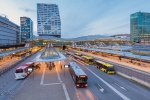
Rapid urbanisation
Cities are becoming increasingly more important in the global economy. In addition, metropolitan regions in which cities seek cooperation to achieve higher competitiveness and to cope with the challenges that they face have an increasingly prominent role in our society. Municipalities, companies, education and health care institutions will have to take this into account.
Acceleration of urbanisation
In 1800, only two percent of the world’s population lived in cities. In 1950, this percentage had risen to thirty percent and in 2007,a milestone was reached when, for the first time, more than half of the global population lived in cities. Today, there is a discernible acceleration of this urbanisation, with the number of city dwellers growing by a half million each week. This means that, in 2030, sixty percent of the world population will live in urban regions.
Discernible trend in Europe as well
Accelerating urbanisation is not only occurring in regions where expected population growth is high and the number of people living in cities is relatively low, such as Asia and Africa. This trend is also happening in Europe. The number of residents in London is, for example, growing twice as fast as in the rest of the UK. In the Netherlands, a similar picture may be painted. The increase is not only a result of natural population growth but due, in particular, to more Dutch and foreign migrants moving into cities.
Higher demands on infrastructure
This accelerated growth of urban populations imposes higher requirements on the infrastructure around cities and is responsible for a greater demand on such services as health care as well as food, energy and safety. Although cities only occupy a half percent of the land area worldwide, their residents consume 75 percent of natural resources. This raises questions about whether the existing social or physical infrastructure can accommodate such growth and where the priorities lay in terms of needed investment. Conversely, there are also areas of depopulation where the precisely opposite issues are at play.
Challenges for municipalities and the business community
Accelerating urbanisation presents municipalities with the challenge of sustainably absorbing this growth and keeping cities liveable given limited resources. It also offers the business community opportunities and challenges as well, this not only in the form of products and services that a city can support when absorbing this growth, but by the fact that new consumer groups are being created and a corresponding demand for new products is being generated. The liveability of a city is, in turn, precisely one of the factors that determines if the city is attractive to residents, students, visitors and companies to locate their business and to develop social and economic activities. Such activities subsequently nurture further growth of the city and region.

Related content


Technological change
New technologies give rise to a gap. Many of these technologies have already generated a great deal of discussion. Examples include the implementation of...

Demographic changes
While population growth in the Netherlands is decreasing, there will be an additional billion people in the world by 2025. We are growing older; in 2000, a...

Shift in economic power
The shift in economic power will have a large impact on growth potential for companies and the countries in which future investments will be made.
Contact us

















